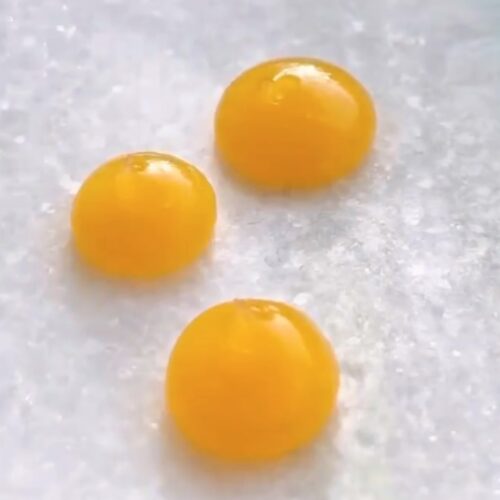
Orange Fluid Gel
Orange Fluid Gel, a burst of vibrant citrus flavour, encapsulated in a smooth texture, perfect for elevating desserts, cocktails, and savoury dishes with a touch of zestful sophistication.
Equipment
- Blender or Food processor
Ingredients
- 2 cups fresh orange juice (divided. See note #1.)
- 2 tbsp sugar
- 3 tbsp lemon juice
- 2 tsp Agar agar or 2 tsp gelatin (see notes for Agar Vs. Gelatin)
Instructions
- Freshly squeeze 2 cups of orange juice and divide into 2 cups.
- Add 1cup of the juice into a pot and reserve the remaining cup for later use.
- Add the sugar and agar to the pot and whisk well.
- Bring to a boil over medium heat for 1-2 minutes, then remove from heat.
- Add the lemon juice to the uncooked cup of orange juice
- Whisk the uncooked orange/lemon mix into the cooked juice mixture, whisking to incorporate.
- Transfer to juice mix to a shallow pan and place in the fridge to cool for 30 minutes.
- Once mixture is firm, transfer to a blender and blitz until smooth.
- Transfer orange fluid gel to a squeeze bottle for easy use and plating.
Notes
- You can use store-bought orange juice; if you do use store bought juice, omit the sugar.
- Experiment with different juices such as cranberry, apple, grape, or any juice of your choice.
- Storage: Store the fluid gel in an airtight container in the fridge for up to 5 days.
- Consistency of Liquid: Ensure the liquid is free of solids or impurities, as these can affect the texture and consistency of the gel. A smooth, well-strained liquid works best.
- Temperature of Liquid: The liquid should be at room temperature or slightly warm when adding agar or gelatin to ensure smooth incorporation and prevent clumping. If using agar, be sure to bring the liquid to a boil to activate it properly.
- Vegetarian Option: Replace gelatin with agar agar to make the recipe vegetarian-friendly.
- Gelatin vs. Agar: Agar creates a firmer texture, while gelatin results in a softer, more delicate gel. You may want to use slightly less agar to achieve a similar texture to gelatin.
- Additionally, agar sets at room temperature but requires boiling to activate its gelling properties, unlike gelatin, which dissolves in cold liquid.
- Feel free to experiment with both to achieve your desired consistency.
- Derived from animal collagen (typically cows or pigs).
- Sets at a lower temperature, solidifying at room temperature or slightly cooler.
- Produces a softer, delicate, and smooth texture.
- Not suitable for vegetarians or vegans.
- Plant-based, extracted from seaweed.
- Requires colder temperatures to set.
- Produces a firmer, slightly chewy texture.
- Suitable for vegetarian and vegan diets.
Tried this recipe?
 Mention @thewifewiththeknife or tag #wifewiththeknife
Mention @thewifewiththeknife or tag #wifewiththeknife